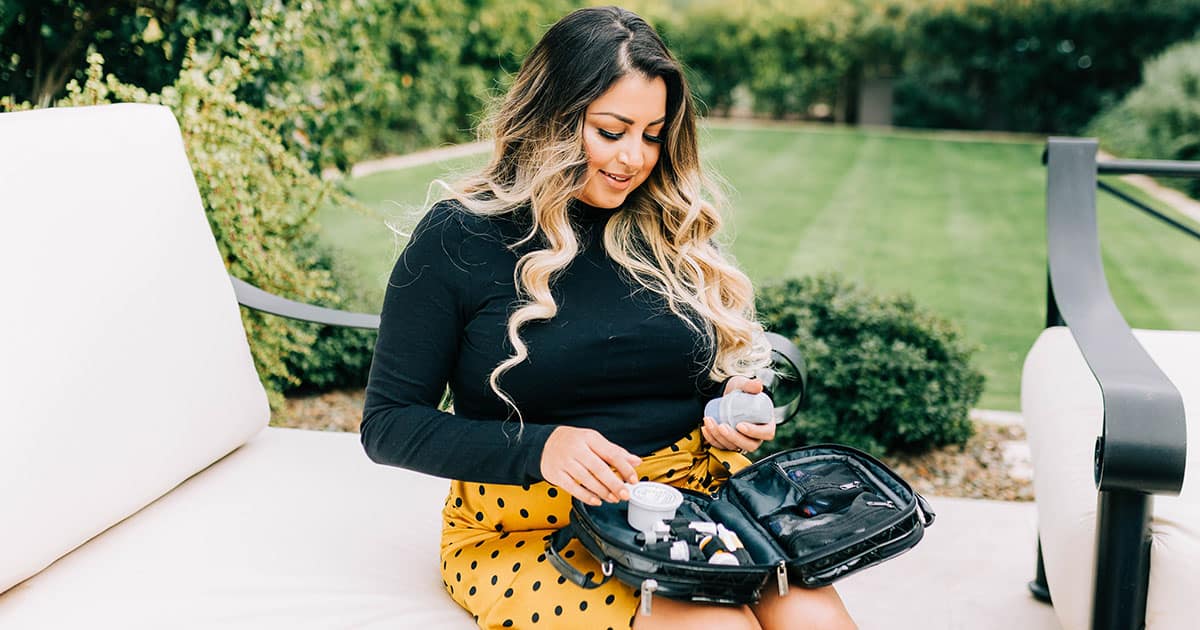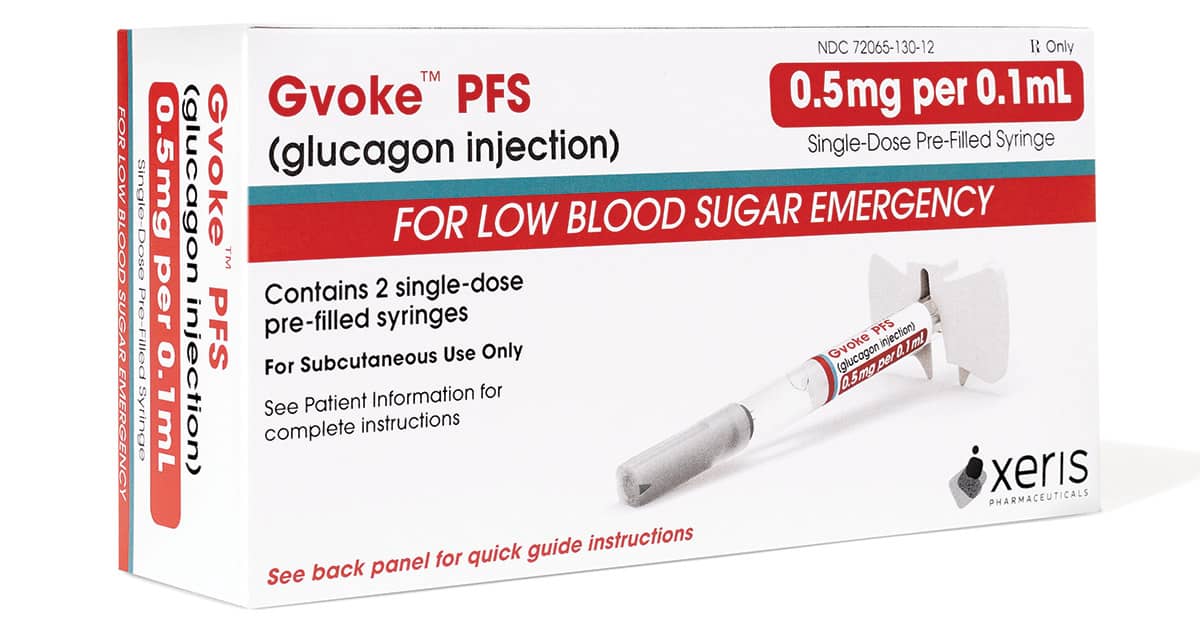Do you have a low blood sugar plan?
If you live with insulin-dependent diabetes, low blood sugar is an unavoidable part of life and something to prepare for by always having carbohydrates like glucose tablets or juice with you.
But low blood sugar can sometimes creep dangerously low, which is why we should also prepare for severe low blood sugars or situations where we simply cannot eat more carbohydrates.
Historically, we’ve had very limited options when it comes to treating those scary severe lows, but once Gvoke® (glucagon injection), the first pre-filled glucagon became available, we finally had a ready-to-use option.
I had a chance to sit down with Paloma Guerrero (aka GlitterGlucose), who has been living with type 1 diabetes since 2013, to discuss her experiences with severe lows and how to properly prepare for a very low blood sugar emergency.
This post is sponsored by Xeris Pharmaceuticals, Inc. the manufacturer of Gvoke HypoPen® (glucagon injection).

What is low blood sugar and why is it scary?
Low blood sugar (Hypoglycemia) can feel different for different people, both when it comes to when we feel low and how the symptoms manifest.
In a non-diabetic body, blood sugar levels rarely dip below 70 mg/dL, but if you manage your diabetes with insulin (or other blood sugar-lowering drugs) and if too much insulin is present in the body, blood sugars start to drop below normal levels.
Without enough glucose (a form of sugar) in your bloodstream, your brain and entire body will struggle to function and most people will start feeling the symptoms of low blood sugar.
If not treated with glucose, blood sugar can continue to drop, which can lead to a severe low blood sugar. A severe low blood sugar is defined as a situation where your blood sugar is so low that you need help from someone else to get your blood sugar back into a safe range.
Paloma’s story
Using a glucagon kit wasn’t something that was top of mind for Paloma until she experienced two very bad low blood sugars only a week apart. In one situation she was prepared and in one she was not.
The first time, she was on a road trip with a friend. She had brought all of her diabetes supplies including Gvoke. Her friend knew where it was and how to use it should she need it.
As they arrived at their hotel, Paloma checked her CGM and saw that she was 179 mg/dL (9.9 mmol/L), but within the next hour, she started to feel low. She felt sweaty and was shaking. She checked her CGM again and now her blood sugar was 52 mg/dL (2.9 mmol/L) and her CGM was showing an arrow pointing down, indicating her blood sugar was dropping.
She started to eat her emergency low snacks, but this low felt different, and as her blood sugar continued to drop, she began to fear that she would pass out. At that point, her friend got the Gvoke for her. Paloma injected it into her thigh and felt a sense of relief knowing she had taken a medicine proven to bring blood sugar up and that she was going to be OK.
Her blood sugar steadily went up and topped out at 237 mg/dL (13.2 mmol/L) before settling at 180 mg/dL (10 mmol/L).
Gvoke was the right tool for that situation and it corrected her low without putting her on a 24-hour blood sugar roller coaster.

What can happen when we don’t prepare for a low blood sugar
The week after, Paloma and her friend were on the road again. This time she didn’t bring Gvoke (didn’t think she’d need it two weeks in a row) and as she was trending low during the trip, she ate all of her low snacks before they arrived at their hotel.
That night, she woke up and checked her CGM to find that her blood sugar had dropped to 40 mg/dL (2.2 mmol/L), and that’s when her low symptoms intensified, and she started feeling poorly. But she was out of snacks and didn’t have her glucagon with her, so there was no way of treating the low.
Her friend ran to the vending machine in the hallway, but it was malfunctioning. As time was ticking, her friend ended up punching through the glass of the machine to get to the snacks.
At this point, they were both panicking and once her friend returned with the snacks, Paloma ate as much as she could. This experience left them both emotionally drained and she had to fight resistant high blood sugars throughout the following day.
How these experiences have changed how she prepares for a low blood sugar
Both severe low situations were scary, but even though her blood sugar dropped most aggressively during the first episode, it felt more controlled and less emotionally exhausting, as she knew she had the right treatment with her, which was Gvoke.
Because it’s pre-mixed and ready to go with no visible needle, she wasn’t nervous about whether her friend would be able to use it should she need assistance.
She has made some changes to her care after the two low episodes, and now wears a newer CGM model that will alert her if her blood sugars are dropping below range. She also carries Gvoke HypoPen with her at all times, tells those around her where it is, and is confident that those around her will be able to use it if needed.
I asked if she had any words of advice for others living with diabetes and this is what she said:
“Emergencies happen. Even if we think it will never happen to us, sometimes it does, so to be prepared for such situations is incredibly important. And the thing is, we don’t have to be scared of low blood sugars if we’re prepared and have the right solutions with us. For me, knowing that Gvoke works, it’s ready to use, and that it doesn’t wreck my blood sugars has meant a world of difference, and now I don’t go anywhere without.”
What is Gvoke HypoPen and how to get it
Gvoke HypoPen can be used to treat a severe low blood sugar if you or someone around you experience one or more of the following:
- have repeatedly tried correcting with food or drink and it isn’t working
- are unable to swallow safely
- feel like you/they might pass out
- experience loss of consciousness or a seizure
Gvoke is the only premixed glucagon approved for children 2 years and up and you don’t have to worry about measuring out the glucagon dose as Gvoke comes in 2 pre-measured doses – one dose for adolescents and adults (1.0 mg) and one for kids age 2 and above (0.5 mg).
Kids younger than 12 who weigh at least 100 pounds may be prescribed the 1.0 mg dose.
Gvoke is a prescription drug so you need to reach out to your doctor and request a prescription. If you have commercial insurance, you can also go directly through GvokeGlucagon.com and request a prescription to be delivered directly at your door.
For a limited time, Xeris Pharmaceuticals is offering a $0 copay for commercially eligible patients to help ensure as many people as possible can access Gvoke HypoPen.
——————
Important Safety Information
Gvoke is a prescription medicine used to treat very low blood sugar (severe hypoglycemia) in adults and kids with diabetes ages 2 year and above. It is not known if Gvoke is safe and effective in children under 2 years of age.
Do not use Gvoke if you have a tumor in the gland on top of your kidneys (adrenal gland), called a pheochromocytoma; you have a tumor in your pancreas, called either insulinoma or glucagonoma; you are allergic to glucagon or any other inactive ingredient in Gvoke.
Gvoke may cause serious side effects, including high blood pressure: Gvoke can cause high blood pressure in certain people with tumors in their adrenal glands. Low blood sugar: Gvoke can cause low blood sugar in certain people with tumors in their pancreas. Serious skin rash: Gvoke can cause a serious skin rash in certain people with a tumor in their pancreas called glucagonoma. Serious allergic reaction: Call your doctor or get medical help right away if you have a serious allergic reaction including rash, difficulty breathing, low blood pressure. US-SM-GVKHP-21-00081
See Important Safety Information: http://bit.ly/2lJdBjY
See Full Prescribing Information: http://bit.ly/2lRtk07




Melanie Nikdel
Hi Christel, I’m curious about how Gvoke compares to the inhaled glucagon (bagsimi) in terms of effectiveness and side-effects? I’ve heard that glucagon treatments can cause vomiting. And Paloma’s friend deserves a medal for punching through the vending machine glass — that’s a diabetes hero! <3
Christel Oerum
He really does deserve a medal!
When I’ve looked into the side-effects of the different glucagons available (I’ve done a deep dive on every one of them on YouTube) they seem very similar. The only real difference seems to be that Baqaimi reports upper respiratory tract irritation as a side-effect and I’ve heard people say that they got nosebleeds